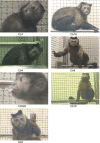Relevance of animal models to human tardive dyskinesia
- PMID: 22404856
- PMCID: PMC3338072
- DOI: 10.1186/1744-9081-8-12
Relevance of animal models to human tardive dyskinesia
Abstract
Tardive dyskinesia remains an elusive and significant clinical entity that can possibly be understood via experimentation with animal models. We conducted a literature review on tardive dyskinesia modeling. Subchronic antipsychotic drug exposure is a standard approach to model tardive dyskinesia in rodents. Vacuous chewing movements constitute the most common pattern of expression of purposeless oral movements and represent an impermanent response, with individual and strain susceptibility differences. Transgenic mice are also used to address the contribution of adaptive and maladaptive signals induced during antipsychotic drug exposure. An emphasis on non-human primate modeling is proposed, and past experimental observations reviewed in various monkey species. Rodent and primate models are complementary, but the non-human primate model appears more convincingly similar to the human condition and better suited to address therapeutic issues against tardive dyskinesia.
Figures


Similar articles
-
Parallels between behavioral and neurochemical variability in the rat vacuous chewing movement model of tardive dyskinesia.Behav Brain Res. 2012 Jun 1;231(2):323-36. doi: 10.1016/j.bbr.2012.03.045. Epub 2012 Apr 6. Behav Brain Res. 2012. PMID: 22503783
-
Co-Expression of Tardive Dyskinesia and Drug-Induced Parkinsonism in Rats Chronically Treated With Haloperidol.Neuropsychopharmacol Rep. 2025 Mar;45(1):e12524. doi: 10.1002/npr2.12524. Neuropsychopharmacol Rep. 2025. PMID: 39789385 Free PMC article.
-
Animal models of tardive dyskinesia--a review.Indian J Physiol Pharmacol. 2001 Apr;45(2):148-60. Indian J Physiol Pharmacol. 2001. PMID: 11480221
-
Distinguishing akathisia and tardive dyskinesia: a review of the literature.J Clin Psychopharmacol. 1983 Dec;3(6):343-50. J Clin Psychopharmacol. 1983. PMID: 6139392 Review.
-
Animal models of tardive dyskinesia.Int Rev Neurobiol. 2011;98:265-87. doi: 10.1016/B978-0-12-381328-2.00011-0. Int Rev Neurobiol. 2011. PMID: 21907091 Review.
Cited by
-
Current Methods for the Treatment and Prevention of Drug-Induced Parkinsonism and Tardive Dyskinesia in the Elderly.Drugs Aging. 2018 Nov;35(11):959-971. doi: 10.1007/s40266-018-0590-y. Drugs Aging. 2018. PMID: 30357723 Review.
-
Polymorphism of the 3'-UTR of the dopamine transporter gene (DAT) in New World monkeys.Primates. 2017 Jan;58(1):169-178. doi: 10.1007/s10329-016-0560-0. Epub 2016 Aug 8. Primates. 2017. PMID: 27503104
-
Genetic Factors Associated With Tardive Dyskinesia: From Pre-clinical Models to Clinical Studies.Front Pharmacol. 2022 Jan 24;12:834129. doi: 10.3389/fphar.2021.834129. eCollection 2021. Front Pharmacol. 2022. PMID: 35140610 Free PMC article. Review.
-
Antipsychotic dosing: found in translation.J Psychiatry Neurosci. 2014 Jul;39(4):223-31. doi: 10.1503/jpn.130191. J Psychiatry Neurosci. 2014. PMID: 24467943 Free PMC article. Review.
-
Oxidative stress and the antipsychotic-induced vacuous chewing movement model of tardive dyskinesia: evidence for antioxidant-based prevention strategies.Psychopharmacology (Berl). 2014 Jun;231(11):2237-49. doi: 10.1007/s00213-014-3582-6. Epub 2014 Apr 22. Psychopharmacology (Berl). 2014. PMID: 24752659 Review.
References
-
- Blanchet PJ. Antipsychotic drug-induced movement disorders. Can J Neurol Sci. 2003;30(Suppl 1):S101–107. - PubMed
-
- Marshall DL, Hazlet TK, Gardner JS, Blough DK. Neuroleptic drug exposure and incidence of tardive dyskinesia: a records-based case-control study. J Man Care Pharm. 2002;8:259–265. - PubMed
-
- Woods SW, Morgenstern H, Saksa JR, Walsh BC, Sullivan MC, Money R, Hawkins KA, Gueorguieva RV, Glazer WM. Incidence of tardive dyskinesia with atypical versus conventional antipsychotic medications: a prospective cohort study. J Clin Psychiatry. 2010;71:463–474. doi: 10.4088/JCP.07m03890yel. - DOI - PMC - PubMed
-
- Lee PE, Sykora K, Gill SS, Mamdani M, Marras C, Anderson G, Shulman KI, Stukel T, Normand SL, Rochon PA. Antipsychotic medications and drug-induced movement disorders other than parkinsonism: a population-based cohort study in older adults. J Am Geriatr Soc. 2005;53:1374–1379. doi: 10.1111/j.1532-5415.2005.53418.x. - DOI - PubMed
Publication types
MeSH terms
Substances
Grants and funding
LinkOut - more resources
Full Text Sources
Medical
Miscellaneous

